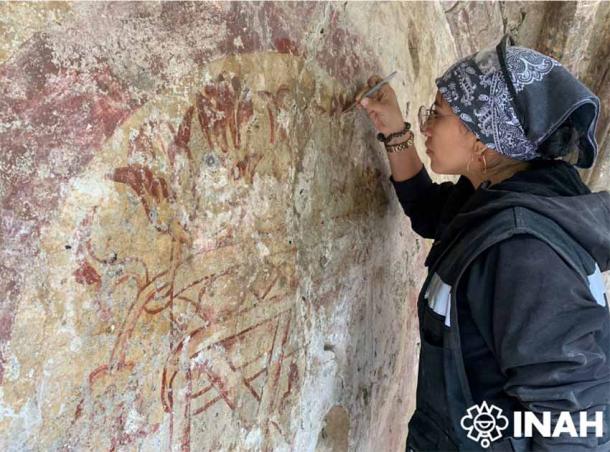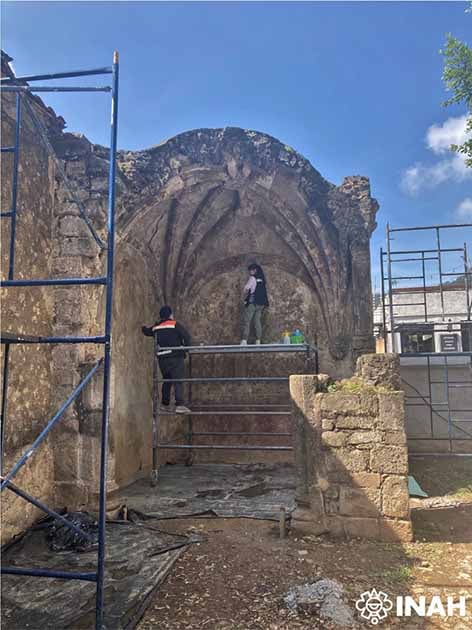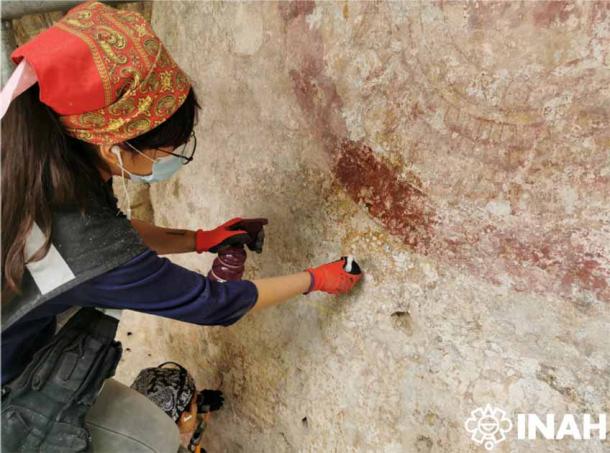Archaeologists working at a Mexican holy site thought they were rediscovering a lost image of the Virgin Mary. But Mary never wore a feather plume, and seldom was she depicted within red circles. The pre-Hispanic mural turned out to be a representation of a Mesoamerican shield, related to the Aztec god of alcohol and drunkenness Tepoztecatl!

Valeria López Mancera during restoration work of the pre-Hispanic painting at the Convent of Tepoztlán. (Jose Morales / INAH)
Aztec Mural Found on Convent Facade
Tepoztlán city is located in the Mexican state of Morelos, to the south of Mexico City , within El Tepozteco National Park. This is the legendary birthplace of Quetzalcoatl, the Aztec divine feathered serpent. In ancient times this site was dominated by the Aztec Tepozteco pyramid that was built on a dramatic cliff top above the town.
The former Dominican monastery, the Tepoztlán Ex-Convento de la Natividad (Convent of Tepoztlán), was built between 1555 and 1580 AD. Dedicated to the Nativity of the Blessed Virgin Mary, Travel by Mexico explained that this “Dominican Temple has a large atrium, an open chapel, chapel posas or quadrangular vaulted structures located at the edge of the courtyard, the church, and convent.”
In 1993, INAH archaeologists began restoring the convent facade which depicts the Virgin Mary , Fray Domingo de Guzman (founder of the order of Dominica) and Saint Catherine of Siena. Almost 30 years later, INAH announced that a team of researchers had made a highly-unexpected discovery. Painted on the walls of 3 poza chapels they found “rare pre-Hispanic iconography” connected to an Aztec god!

Archaeologists during excavation work at the Convent of Tepoztlán where they uncovered pre-Hispanic painting. (Frida Mateos / INAH)
The excavation was funded by the UNESCO World Heritage List as part of the First Popocatépetl Monasteries project. Frida Itzel Mateos González, the project leader, explained that the researchers had undertaken restoration of several artworks, including mural paintings and carved stones.
According to the INAH report, the researchers first removed several layers of lime that covered the paintings in Chapel 4. To their surprise, they discovered “a well-preserved red circle” dating back to the early 16th century. The circle measured 11 centimeters (4,33 in.) thick and just over a meter (39,37 in.) in diameter. These dimensions match those of a 16th century Marian shield that was also painted in the Posa chapels.
The researchers said the red circle was painted freehand with diluted red paint before it was then filled with glazes. The team next charted a series of triangles which they incorrectly assumed were part of the “crown or splendor of the Virgin Mary.” However, it was soon realized that this was actually a plume of feathers like that seen in many Aztec murals!

Restoration work taking place on the pre-Historic painting discovered in Mexico. (Jose Morales / INAH)
Ancient Chimalli – A Pre-Hispanic Shield
Also painted within the red circle was a wand with flowers and a tepoztli (ax). This was no Christian panel, but an ancient chimalli, the traditional defensive armament of the indigenous states of Mesoamerica, which were often decorated with feathers, jade strings and seashells.
The archaeologists said the painted chimalli “connects the current population of Tepoztlán with their ancestry.” Furthermore, their report claimed that the painting was evidence of “transformations of Tepoztecan society.” The Art Newspaper highlighted that “it is possible that the new find relates to Tepoztecatl” the Aztec god of pulque, an alcoholic Aztec drink, who was worshiped at the nearby El Tepozteco site. Tepoztecatl was also the god of drunkenness and fertility.
The INAH archaeologists stated that a similar circle appears on the walls of Chapels 2 and 3 at the Convent of Tepoztlán . This repeated usage of the same indigenous image, and in one instance right beside an anagram of the Virgin Mary in a Christian building, has raised the question – what is a mural connected to the Aztec god of alcohol and drunkenness doing in a 16 th century Christian church?
Top image: Hand-drawn illustration superimposed over a photo of the pre-Hispanic painting. Source: Frida Mateos / INAH
By Ashley Cowie
Related posts:
Views: 0
 RSS Feed
RSS Feed
















 October 14th, 2022
October 14th, 2022  Awake Goy
Awake Goy  Posted in
Posted in  Tags:
Tags: 
















